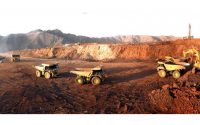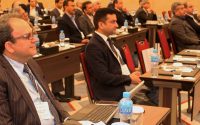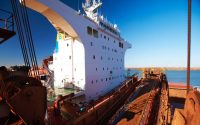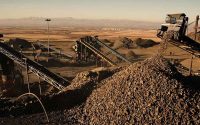IMIDRO chairman concedes that foreign investment is imperative to revolutionise the massive mining industry in Iran
Prof. Keyvan Jafari Tehrani, head of international affairs at Iron Ore Association of Iran (IROPEX), has pointed out the statistics released by Iran Customs Administration in connection with the foreign trade during the first four months of the Iranian year 1395 (from March 21st through July 21st, 2016) and said, “The statistics show that Iran steel industry has performed above the expectations and has exported more than two million tones (MT), which is more than a 77 % increase in comparison with the same period of the preceding year. By taking into account of different types of steel products, we exported 2.52 MT of steel amounting to US$124,276,000. The export of steel products in between June 21stto July 21st, 2016 has been 521,400 tonnes, which shows an 86 % growth in comparison to the same month in the past year and is above the average of the first four months of the year.
Mobarakeh Steel Company gained the first rank which is followed by Hormozgan Steel Company. The planned export for the current Iranian year 1395 (March 21st, 2016 – March 20th, 2017) has been 6 Million Ton and we can say that the same will be fully achieve able based on statistics announced by Iran Customs Administration.”
He stipulated that the production statistics show copper concentrate, iron ore concentrate and molybdenum production have taken the upper ranks. In the other words, Iran is taken steps forward for production and export of concentrate of base metals because they will result in more profit and added value.
Prof. Tehrani added, “According to the statistics, the production of copper concentrate has been more than 371,000 tonnes during the first 4-month of the current Iranian year, which shows 22.84 % increase in comparison with the same period of the preceding year. The iron ore concentrate production amounts to 9.6 MT with 15.84 % increase in comparison with the same period of the preceding year. The production of iron ore fines & lump during the same period was 2.14 MT with 16.55 % decrement. This statistics also shows that we have had a 3.9 % increase in sponge iron production and produced 5.5 MT but the pellets and billet productions have been 7.9 MT and 4.75 MT with 0.37% and 3.33% decrease, respectively in comparison with the same statistics of the preceding year. Since new pelletizing plants will be commissioned this year, it will result in increase in pellets production in the current year.”
Tehrani further discussed pellets production complexes in Iran and added, “26 pelletizing plants with total production capacity of 54 MT are under construction and this will result in increase of pellets production capacity to more than 70 MT, which is enough for production of 50 MT of steel. As the planned target by the end of 6th Development Plan is not more than 40.3 MT, there will be some extra quantities, which can be exported as pellets itself or to produce DRI and export the same. Considering the increase in the price of pellets in comparison to iron ore (pellets price increment was 69% while for iron ore it was 39% only), it’s evident that exporting pellets is more profitable. By opening of Gol-e-Goharnew pelletizing plant with 5 MT annual production, Iran can get advantage to start exporting pellets between October 2016 and March 2017).
Pointing out statistics released by World Steel Association, Tehrani added, “There has been no change in the position of Iran among steel producers in the so far, and the country has stayed in 14th rank. During this period, the production of crude steel by Iranian producers has been 10,120,000 tons. Based on statistics released by the association, production of crude steel in Iran has had 4.9% increment in comparison with the same period of the preceding year and it has been reached to 9,645,000 ton. The steel production of Iran in July has been 1,370,000 ton which had 7.6% increment in comparison to July 2015 but the production of June has been less than the same month in 2015, which had been 1,534,000 ton. Iran is placed 14th worldwide after China, Japan, India, USA, Russia, South Korea, Germany, Turkey, Brazil, Ukraine, Italy, Taiwan and Mexico.”
Going further, Tehrani discussed foreign trade statistics of Iran and pointed out that the investigation of statistics of foreign trade of Iran from March 21st, through July 21st, 2016 indicates that there has been 40% increase in export of iron ore with less than 40% iron content. The total figure for export of both iron ore Fines & Lump with Fe content above 40% along with concentrate during this period has been touched to 5,790,000 ton, which equals to US$227,161,000.
In the other commodities such as cement products, exports were at 4.3 Million ton, valued at US$165,913,000. The total amount of lead exported was 49,000 ton, amounting to US$65.6mn and 44,600 Ton zinc amounting to US$53.mn. The value of export of aluminum products has been 39,500 Ton amounting to US$50.2mn.
He then pointed out: “Statistics released by Iran Customs Administration shows that except for drop in export of both cement and aluminum, which for cement had been the result of limitations imposed on import to Iraq, we have had an increase in export of all other mining & base metal products like iron ore, copper, steel, lead and zinc.”
In connection with the opportunities for foreign direct investment (FDI) in Iranian mines and steel industries he said: “As Chairman & Managing Director of IMIDRO, Dr. Mehdi Karbasian stated that according to the 6th Development Plan, there are great opportunities for FDI in the mine and mining industry development projects, especially in steel, aluminum, copper and zinc sectors. In the mining sector, by taking into account the importance of exploration, Iran is mainly desired to attract foreign investment in exploration and completion of mine chain and then added value projects up to production of the end products such as copper or steel.”
Dr. Karbasian then pointed out – “I believe that Joint Comprehensive Plan of Action (JCPOA) has created the most important opportunity for development of investment in mine and mine industries sector. Other parameters are decrease of inflation rate and fixed exchange rate, which in turn indicate the economic stability that is prerequisite for investment in any country including in Iran. The decrease of inflation rate below 10, which had been among the targets of the 11th government and has been seriously followed up, has drawn much more attention this year and this will help the promotion of the situation as well. On the other hand, the Iranian market is a good marketplace for steel products. In addition to local markets, there are good opportunities for export to the neighboring countries. Also, the abundant iron ore reserves, availability of low cost energy and less expensive raw materials and reasonable labor cost are among other privileges of Iranian market. The privatization of public complexes will result in higher productivity as well.”
He continued, “According to several investigations, the total decisive and probable iron ore reserves is 5.1bn ton including 54% (equal to 2,793,295,000 ton) as decisive reserve and 46% (equal to 2,359,012,000 Ton) as probable reserve. Among this figure 34% are located at Gol-e-Gohar (Central South Iran) region, 31% in Central Iran region and 22% in Sangan (North East Iran) region.
The Head of International Affairs of Iron Ore Association of Iran addressed the targets sought by Iran in steel production sector and added: “According to the Iranian Vision Plan 2025, the steel production by the end of year 2025 will be 55 MT out of which 40 MT will be consumed locally. For the purpose of realization of this plan and building infrastructures almost US$30 bn foreign investment is required. In addition, by the end of 2025, the copper production will be increased to 450,000 ton and aluminum production is expected to touch 1.5 MT. Iran also has other plans for production of metals & commodities with higher added value like titanium, petroleum coke, coal, and rare earth elements (REE).
The most important challenge associated with the investment in Iran is the lack of adequate support of the industries & mining sectors by local banking system due to not availability of enough cash flow. “By absorbing as much as possible foreign direct investment, we may achieve our goal.”

Written by Prof. Keyvan Jafari Tehrani, head of international affairs at Iron Ore Association of Iran (IROPEX). Professor Tehrani will be making a presentation on Iran’s mining sector at the inaugural Focus Iran Summit 2016 on 27th September.
Source: imarketmetrics





